 Ryanne Doherty is an International Program Consultant in Explorica’s Boston headquarters. She studied abroad in Florence and traveled to five other Italian cities.
Ryanne Doherty is an International Program Consultant in Explorica’s Boston headquarters. She studied abroad in Florence and traveled to five other Italian cities.
Read about her top Italian highlights:
Best known for ancient ruins, Renaissance masterpieces, and culinary expertise, Italy has plenty to offer everyone who sets foot on its soil. When I spent four months living and studying in Florence, I experienced the diversity of the Italian lifestyle, landscape, culture, and cuisine from the canals of Venice to the lemon groves of the Amalfi Coast, and everywhere in between.
Florence
I spent my days among locals and tourists alike, each of us experiencing centuries of Florence’s influential political and artistic history as we strolled the cobblestoned streets. My temporary home was in the Santa Croce neighborhood, where shops, bars, and restaurants all surround the Gothic Franciscan church of the same name. Arnolfo di Cambio’s Basilica di Santa Croce is the resting place of a number of famous Florentines, such as Michelangelo, Machiavelli, and Galileo. The neo-Gothic marble facade of pink and green hues mirrors that of the city’s most recognizable masterpiece, the Duomo.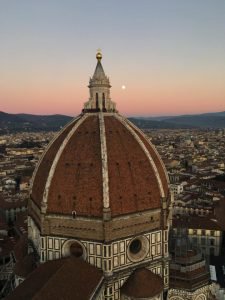
Cattedrale di Santa Maria del Fiore, more commonly known as Il Duomo, is the nucleus of historic Florence. The exterior boasts intricate carvings and sculptures among the white, pink, and green marble, which unites it with neighboring Baptistery and Giotto’s bell tower. Inside, the cathedral is decorated with artistic gems from the marble floors to Giorgio Vasari’s stunning interpretation of The Last Judgement painted on the dome’s interior. The highlight, however, is Brunelleschi’s dome, which stands as a symbol of Florence’s accomplishments in the arts. The height of the dome proved useful during my first few weeks of navigating the city; if I got lost in the winding streets and saw the dome peeking out over the buildings, I’d follow it to find my way through Florence.
Directly south is Piazza della Signoria, a popular meeting place for both Florentines and tourists. Every day, I passed through this piazza, whether it was strolling with friends to a restaurant for pasta with wild boar ragu, walking to a museum such as the Uffizi or Palazzo Strozzi, or browsing the Loggia dei Lanzi and snapping pictures of the outdoor gallery’s famous sculptures for my photography class. From the window of my nearby apartment, I could even see the bell tower of Florence’s seat of political power, Palazzo Vecchio, below which stands a replica of Michelangelo’s David, eyes pointing in a warning gaze toward the rival city of Rome.
Rome
Italy’s most famous landmark, the Colosseum, represents the success and power of Ancient Rome. Earthquakes, erosion, and invasions have broken down the Colosseum’s structure, but this gives a better sense of the centuries of changes in power that it endured. Most commonly known for hosting gladiator battles, the world’s largest amphitheater was also used for executions, mythological dramas, workshops, housing, and much more. Of the 50,000 seats in the amphitheater, the best seat was saved for the Emperor, while the rest were divided based on social and economic class. Passing through the rows and rows of seats, I looked into the center of the Colosseum and saw the passageways where gladiators and exotic animals were kept before running out to battle.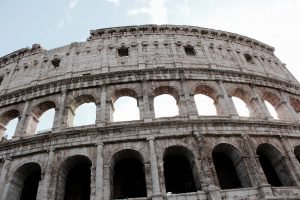
As I followed the footsteps of emperors, politicians, and civilians, the stone and multicolored marble structures of the neighboring Roman Forum towered over me, imposing even in their ruined state. Home to political buildings where elections, speeches, and executions took place, as well as Rome’s earliest temples and shrines, the Forum still stands as an immersive piece of ancient society.
Rome’s countless piazzas attract crowds to see more of the Eternal City’s artistic and architectural wonders. In Piazza della Rotonda, the stately Pantheon stands, showcasing Rome’s changing belief system from the mythological ancient gods to modern Christianity. This continuous use throughout the centuries has made it one of the best-preserved buildings of Ancient Rome.
Nearby Piazza Navona dates back to the first century. Surrounded by bars, restaurants, and street artists, the center of the piazza is Fontana dei Quattro Fiumi, or Fountain of Four Rivers. Bernini’s 17th-century classical fountain personifies the four major rivers of Europe (Danube), Africa (Nile), Asia (Ganges), and the Americas (Río de la Plata), the continents where the papacy spread its authority.
Another highlight of any visit to Rome, the Trevi Fountain, brings travelers to ponder the baroque fountain and toss a coin over their left shoulder, ensuring their return to the city. This touristy practice is actually helpful to the well-being of plenty of Romans, as the over 3,000 euros tossed into the fountain daily are used to fund a supermarket for those in need. Though the Trevi Fountain was completed in 1762, it still represents the influence that Ancient Rome had in art and architecture, long after its collapse.
Pompeii
Rediscovered in 1599, the ancient city of Pompeii provides a detailed glimpse into city life during the Roman Empire. After the eruption of nearby Mount Vesuvius in 79 AD, Pompeii was buried under several feet of volcanic ash, which preserved buildings, art, bodies, and more. Graffiti, frescoes, and street signs line the stone roads throughout the forgotten city.
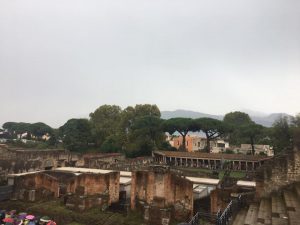 Walking through the streets of Pompeii, I saw the true devastation of the eruption through the broken columns and collapsed walls. The museum displays all that was preserved from kitchenware to bodies frozen in time. Against the outer walls of the archaeological site lies the amphitheater of Pompeii. A survivor of the eruption, the amphitheater still stands intact, with the peak of Mount Vesuvius looming over nearby.
Walking through the streets of Pompeii, I saw the true devastation of the eruption through the broken columns and collapsed walls. The museum displays all that was preserved from kitchenware to bodies frozen in time. Against the outer walls of the archaeological site lies the amphitheater of Pompeii. A survivor of the eruption, the amphitheater still stands intact, with the peak of Mount Vesuvius looming over nearby.
Capri
A drive down the rugged Sorrentine Peninsula and a ferry through the Gulf of Naples, and I was on the island of Capri. The resort island has been in use since Emperor Augustus built his villa there, and it is still a popular vacation spot for wealthy tourists and celebrities. Despite the luxurious lifestyle of the island, I still found plenty to do on a student budget.
The town of Capri offers scenic views of the surrounding bay, artisan sandal shops, and plenty of outdoor dining. In a large piazza, I treated myself to a granita, a local refreshment made from the juice of lemons and oranges from the Amalfi Coast. Another town square, the historic Piazza Umberto I and its clock tower attract tourists for a seat in the shade or a look at Mount Solaro above.
A quick bus ride from town brought me past ancient villas and tree-lined roads to the elevated town of Anacapri. From here, I spent just a few euros on a chairlift up to Mount Solaro, the highest point on this island. On the slow and silent ride to the top, I gazed out over the white houses, emerald terraces, and fragrant lemon groves across Capri. The breathtaking views didn’t cease as I reached Mount Solaro’s peak. Here, a small piazza offers a panorama of the rocky peninsula across idyllic cerulean waters. Erupting out of the sea below are the vertical limestone rock formations, the Faraglioni.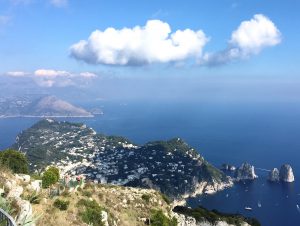
Back at sea level, I sailed around Capri, passing under the archlike formation of the Faraglioni, dubbed “Lover’s Arch.” The boat carefully emerged from under the monumental rock and made its way toward the highlight of any visit to Capri, the Blue Grotto. Access to the Blue Grotto is contingent on a number of things, and if the water is too rough or too high, passing through the one-meter entrance is impossible. Luckily, I made it to the Blue Grotto when the tide was low and the water was calm, so I hopped into a small wooden rowboat led by a local guide. We laid down flat to enter the cave, and as soon as we slipped through, the water glowed an iridescent blue. As the sun shone through an underwater tunnel and illuminated the grotto, the numerous rowboats revolved around the center as the singing guides’ song echoed off the cavernous walls. The Blue Grotto in Capri is one of the rare spots in the world that offers this irreplaceable adventure.
Venice
Across the country off the northeastern coast floats a collection of 118 small islands connected by bridges and cut by canals. The layout of Venice is unique in the world: cars and buses are replaced by gondolas and water taxis, a labyrinth of narrow alleys gives way to piazzas and waterways, and glassblowing, printing, and fashion dominate the art scene. The distinctive lifestyles of Venetians make this chain of islands even more dreamlike than the city alone.
Arriving by train, I exited the station and was shocked by the beauty of the floating buildings and bustling canals. As I walked through the tight pathways and crossed brick and iron bridges, the beauty of Venice seemed to elevate with every step.
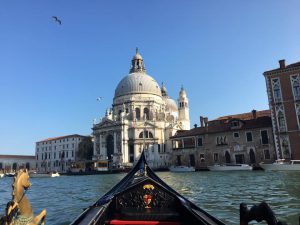 I walked until I found myself in Piazza San Marco, the city’s political, religious, and social center. The piazza is surrounded on three sides by shops and restaurants through columned arches. La Basilica di San Marco stands at the head of the piazza. The basilica’s Italo-Byzantine architecture is accompanied by gold mosaics and Syrian, Egyptian, and Palestinian marble, implemented to symbolize the wealth and power of Venice. It was originally used as the personal chapel of the Doge of Venice and is attached to the Doge’s palace.
I walked until I found myself in Piazza San Marco, the city’s political, religious, and social center. The piazza is surrounded on three sides by shops and restaurants through columned arches. La Basilica di San Marco stands at the head of the piazza. The basilica’s Italo-Byzantine architecture is accompanied by gold mosaics and Syrian, Egyptian, and Palestinian marble, implemented to symbolize the wealth and power of Venice. It was originally used as the personal chapel of the Doge of Venice and is attached to the Doge’s palace.
Palazzo Ducale, the residence of the Doge of Venice, contains apartments, offices, and dining rooms decorated with a wide collection of art from artists such as Bellini, Carpaccio, and Giorgione. The Venetian-Gothic palace is linked to the city prison by the Bridge of Sighs. The white limestone bridge is named for the belief that prisoners would sigh as they peeked through the bridge’s windows at their last view of Venice before being locked in their cells. Anyone who crosses the Bridge of Sighs today will do the same, as the view across the lagoon to the island of San Giorgio Maggiore is breathtaking.
Gliding under Venice’s 400 bridges is the most recognizable symbol of Venice, the gondola. At the edge of a small canal, I hopped aboard one of the sleek black boats, and the gondolier expertly rowed around corners and historic buildings, explaining the significance of each one. While alternating between the lively Grand Canal and the tranquil tributaries, Venice shows off its dynamic energy and antiquated beauty.
Away from the crowds of the city is another collection of islands called Murano, my favorite area of Venice. Famous for its glassmaking industry, Murano is home to the world’s most prominent glassmakers, who still use the same techniques and tools used by their ancestors. I had the opportunity to see a glassmaker in action during my quick visit to Murano. Inside the workshop, the glassmaker took the molten glass out of the furnace and used a blowpipe and tongs to rapidly inflate and shape the glass into a vibrant multicolored vase before it solidified. Finished works of glass art can be found in shops all around Venice or in Murano’s Museo del Vetro, where masterpieces are accompanied by a description of the industry’s rich history.
Venice is the perfect final glimpse of Italy’s incomparable beauty and culture before departure. The city’s distinctive aesthetic will highlight the diversity in the nation’s history and landscape, leaving a lasting impression on all who wander through.
Want to plan a tour with your students? Check out our 57 tours to Italy!

